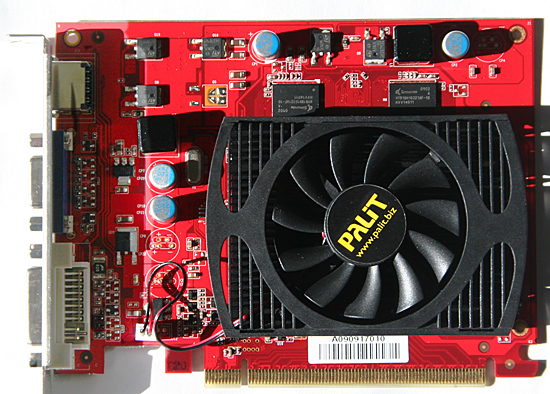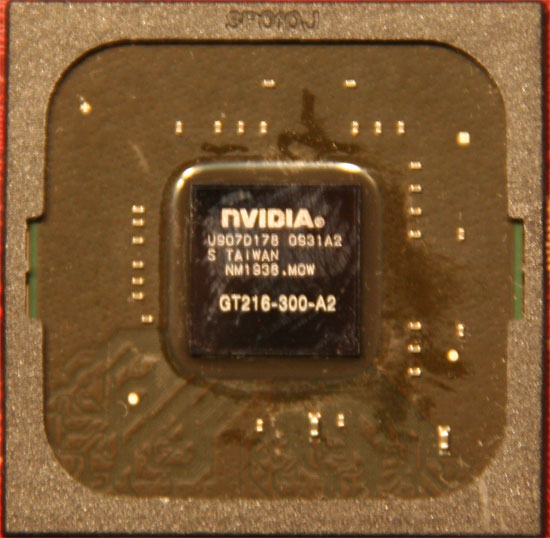NVIDIA’s GeForce GT 220: 40nm and DX10.1 for the Low-End
by Ryan Smith on October 12, 2009 6:00 AM EST- Posted in
- GPUs
There are some things you just don’t talk about among polite company. Politics, money, and apparently OEM-only GPUs. Back in July NVIDIA launched their first 40nm GPUs, and their first GPUs featuring DX10.1 support; these were the GeForce GT 220 and G 210. And if you blinked, you probably missed it. As OEM-only parts, these went into the OEM channel without any fanfare or pageantry.
Today that changes. NVIDIA is moving the GT 220 and G 210 from OEM-only sales to retail, which means NVIDIA’s retail vendors can finally get in on the act and begin selling cards. Today we are looking at one of the first of those cards, the Palit GT 220 Sonic Edition.
| Form Factor | 9600GT | 9600GSO | GT 220 (GDDR3) | 9500GT | G 210 (DDR2) |
| Stream Processors | 64 | 48 | 48 | 32 | 16 |
| Texture Address / Filtering | 32 / 32 | 24 / 24 | 16 / 16 | 16 / 16 | 16 / 16 |
| ROPs | 16 | 16 | 8 | 8 | 8 |
| Core Clock | 650MHz | 600MHz | 625MHz | 550MHz | 675MHz |
| Shader Clock | 1625MHz | 1500MHz | 1360MHz | 1400MHz | 1450MHz |
| Memory Clock | 900MHz | 900MHz | 900MHz | 400MHz |
400MHz |
| Memory Bus Width | 256-bit | 128-bit | 128-bit | 128-bit | 64-bit |
| Frame Buffer | 512MB | 512MB | 512MB | 512MB | 512MB |
| Transistor Count | 505M | 505M | 486M | 314M | 260M |
| Manufacturing Process | TSMC 55nm | TSMC 55nm | TSMC 40nm | TSMC 55nm | TSMC 40nm |
| Price Point | $69-$85 | $40-$60 | $69-$79 | $45-$60 | $40-$50 |
GT 220 and G 210 are based on the GT216 and GT218 cores respectively (anyone confused yet?) which are the first and so far only 40nm members of NVIDIA’s GT200 family. These are specifically designed as low-end cards, with 48 SPs on the GT 220, and 16 SPs on the G 210. The GT 220 is designed to sit between the 9500GT and 9600GT in performance, making its closest competitor the 48SP 9600GSO. Meanwhile the G 210 is the replacement for the 9400GT.
We will see multiple configurations for each card, as NVIDIA handles low-end parts somewhat looser than they do the high-end parts. GT 220 will come with DDR2, DDR3, or GDDR3 memory on a 128bit bus, with 512MB or 1GB of it. So the memory bandwidth of these cards is going to vary wildly; the DDR2 cards will be 400MHz and the GDDR3 cards may go as high as 1012MHz according to NVIDIA’s specs. G 210 meanwhile will be DDR2 and DDR3 only, again going up to 1GB. With a 64bit memory bus, it will have half the memory bandwidth of GT 220.

The GPU configurations will vary too, but not as wildly. NVIDIA’s official specs call for a 625MHz core clock and a 1360MHz shader clock. We’ve seen a number of cards with a higher core clock, and a card with a lower shader clock. Based on the card we have, we’re going to consider 635Mhz/1360Mhz stock for the GPU, and 900MHz stock for GDDR3, and test accordingly.
The transistor count for the GT218 die comes out to 260M, and for GT216 it’s 486M. NVIDIA would not disclose the die size to us, but having disassembled our GT 220, we estimate it to be around 100mm2. One thing we do know for sure is that along with the small die, NVIDIA has managed to knock down power consumption for the GT 220. At load the card will draw 58W, at idle it’s a tiny 7W. We don’t have the power data for the G 210, but it’s undoubtedly lower.

The prices on GT 220 cards are expected to range between $69 and $79, with the cards at the top end being those with the best RAM. This puts GT 220 in competition with AMD’s Radeon HD 4600 series, and NVIDIA’s own 9600GT. The G 210 will have an approximate price of $45, putting it in range of the Radeon HD 4300/4500 series, and NVIDIA’s 9500GT. The GT 220 in particular is in an odd spot: it’s supposed to underperform the equally priced (if not slightly cheaper) 9600GT. Meanwhile the G210 is supposed to underperform the 9500GT, which is also available for $45. So NVIDIA is already starting off on the wrong foot here.
Finally, availability should not be an issue. These cards have been shipping for months to OEMs, so the only thing that has really changed is that now some of them are going into the retail pool. It’s a hard launch and then some. Not that you’ll see NVIDIA celebrating; while the OEM-only launch was no-key, this launch is only low-key at best. NVIDIA didn’t send out any samples, and it wasn’t until a few days ago that we had the full technical data on these new cards.
We would like to thank Palit for providing us with a GT 220 card for today’s launch, supplying us with their GT 220 Sonic Edition.










80 Comments
View All Comments
uibo - Saturday, October 17, 2009 - link
"This could have been a killer HTPC card...one year ago. "... for me to poop on.
VooDooAddict - Monday, October 12, 2009 - link
I'd love to see this around $40 and make it's way into inexpensive OEM desktops. The GT 220 would be perfect for low end desktops if the price gets low enough. This would enable cheap eMachines to play MMOs and keep PC gaming alive.But as it stands right now 4650 and 4670 are the two cards I currently use to build low end desktops for others.
Lonyo - Monday, October 12, 2009 - link
A joke launch for what I can only hope is supposed to be a joke product.Mind you, at least NV have launched _something_ at 40nm for the general market rather than OEMs only.
yoyojam - Monday, October 12, 2009 - link
Glad to see AMD pretty much destroying Nvidia on the graphics front (for now). They're processor division is doing so badly, and we need our CPU competition...MegaSteve - Tuesday, October 20, 2009 - link
I doubt that AMD is destroying or will even destroy Nvidia in any respect. What they are doing is providing them with credible competition and that is what we all benefit from. Although I will say this whole renaming cards and providing meagre performance increases is wearing a little thin.I enjoy the fact that I can choose between similar performance levels in cards from either camp for less money than when the 8800 series came out (I am referring to the GTX/Ultra parts). Now I know I can see your skin turning a solid shade of AMD Red but remember we have no answer from Nvidia yet, so the only thing that has occurred here is that ATI has beaten them to the market - perhaps Nvidia would rather be late and avoid another 5800 Vacuum Cleaner launch, I am sure that cost them dearly.
AMD/Nvidia really have to ensure that they spend time ensuring their products are going to rival the Larrabee/DX 11 threat that very well has the possibility to clean them both up. I would rather have to install a graphics card and a processor of my choice than to have a single intel provider of all in my PC. As you can see nvidia is trying to push multiple uses for their GPU which seems pretty smart to me.
Souleet - Monday, October 12, 2009 - link
They are not destroying NVIDIA. I think we have to wait and see NVIDIA big guns(GT300 series) before we can truly judge who is beating up on who. I consider this a defensive move until Windows 7 release and to see how the market react over the ATI 5800 series. Remember what happen to the ATI 9700/9800 series, we all know what happen after that. :)teldar - Monday, October 12, 2009 - link
ToolSo because nVidia is going to bring out something in 2-4 months, AMD isn't doing better?
And how is an overpriced budget card a response to brand new, high end cards?
They already know how the market has responded to the 5800 cards. As many as they can make are being sold.
Souleet - Monday, October 12, 2009 - link
They only responded because that's like the newest ATI technology since long ass time. When you are down the only way is up or bankrupt. SLI was a knockout blow to ATI and just now they barely catching up.RubberJohnny - Monday, October 12, 2009 - link
Ahh Souleet, you are a candidate for the most uninformed reader on Anandtech.SLI a knockout blow HAHAHA, thats the funniest thing i've read today!
Souleet - Tuesday, October 13, 2009 - link
Really? Then prove to me that SLI wasn't a knockout blow? After SLI came out, who brought ATI? I love ATI but those are the facts. Show me some proof that AMD stock is up since the merger.